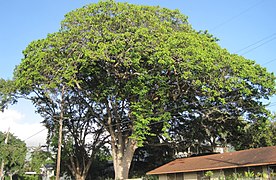bio.wikisort.org - Plant
Hura crepitans, the sandbox tree,[2] also known as possumwood and jabillo, is an evergreen tree of the spurge family (Euphorbiaceae), native to tropical regions of North and South America including the Amazon rainforest. It is also present in parts of Tanzania, where it is considered an invasive species.[3] It can be recognized by its smooth brown bark covered in many dark, pointed spines which have led to its being nicknamed monkey no-climb.[4] Because its fruit explodes when ripe, it has also received the colloquial nickname the dynamite tree.[5][6]
This article uses bare URLs, which are uninformative and vulnerable to link rot. (August 2022) |
| Hura crepitans | |
|---|---|
 | |
| Scientific classification | |
| Kingdom: | Plantae |
| Clade: | Tracheophytes |
| Clade: | Angiosperms |
| Clade: | Eudicots |
| Clade: | Rosids |
| Order: | Malpighiales |
| Family: | Euphorbiaceae |
| Genus: | Hura |
| Species: | H. crepitans |
| Binomial name | |
| Hura crepitans | |
| Synonyms[1] | |
Description
The sandbox tree can grow to 60 metres (200 ft),[7] and its large ovate leaves grow to 60 cm (2 ft) wide. They are monoecious, with red, un-petaled flowers. Male flowers grow on long spikes, while female flowers grow alone in leaf axils. The sandbox tree's fruits are large, pumpkin-shaped capsules, 3–5 cm (1–2 in) long, 5–8 cm (2–3 in) diameter, with 16 carpels arranged radially. Its seeds are flattened and about 2 cm (3⁄4 in) diameter. The capsules explode when ripe, splitting into segments and launching seeds at 70 m/s (250 km/h; 160 mph).[5] One source states that ripe capsules catapult their seeds as far as 100 m (330 ft).[8] Another source states that seeds are thrown as far as 45 m (150 ft) from a tree, averaging about 30 m (100 ft).[7]
Habitat
This tree prefers wet soil, and partial shade or partial to full sun. It is often cultivated for shade.
Uses
Fishermen have been said to use the milky, caustic sap from this tree to poison fish.[9] The Caribs made arrow poison from its sap.[10] The wood is used for furniture under the name "hura". Before more modern forms of pens were invented, the trees' unripe seed capsules were sawn in half to make decorative pen sandboxes (also called pounce pots), hence the name 'sandbox tree'. It has been documented as a herbal remedy, and is available online.[11]
Gallery
- Large sandbox tree in Honolulu
- Hura crepitans in Vietnam
- Hura crepitans in Saint John, U.S. Virgin Islands
- Spiny trunk of Hura crepitans
- Leaf of Hura crepitans
- Hura crepitans fruit carpel
- Hura crepitans fruit carpel, opposite side
References
- "Hura crepitans L." Plants of the World Online. Royal Botanic Gardens, Kew. Retrieved 8 August 2022.
- "Hura crepitans". Germplasm Resources Information Network (GRIN). Agricultural Research Service (ARS), United States Department of Agriculture (USDA). Retrieved 24 December 2017.
- "Factsheet – Hura crepitans (Sandbox Tree)".
- https://www.ajol.info/index.php/njcr/article/view/191072/180248
- Vogel, Steven (March 2008). "The Flight of the Seed of Hura crepitans" (PDF). Archived from the original (PDF) on 2013-06-08.
- Allard, H. A. (1950). "The Sandbox Tree and Its Armament". Bulletin of the Torrey Botanical Club. 77 (6): 509–515. doi:10.2307/2482185. JSTOR 2482185.
- Swain, M. D.; Tom Beer (1977). "Explosive Seed Dispersal in Hura crepitans L. (Euphorbiaceae)". New Phytologist. 78 (3): 695–708. doi:10.1111/j.1469-8137.1977.tb02174.x. JSTOR 2434538.
- Feldkamp, Susan (2006). Modern Biology. United States: Holt, Rinehart, and Winston. p. 618.
- Smithsonian Institution.; Institution, Smithsonian (19 February 2019). "Bulletin /". biodiversitylibrary.org. G.P.O. Retrieved 19 February 2019.
- Jones, David E (2007). Poison Arrows: North American Indian Hunting and Warfare. University of Texas Press. ISBN 978-0-292-71428-1.
- "Hura Brasiliensis. From Materia Medica by John Henry Clarke. Homeopathy".
External links
- Center for Wood Anatomy Research, details about the wood of the Sandbox tree
- (in Portuguese) University of São Paulo: Hura crepitans photos
- www.maya-ethnobotany.org seedpod explosion video
На других языках
[de] Sandbüchsenbaum
Der Sandbüchsenbaum (Hura crepitans) ist eine Pflanzenart in der nur zwei oder drei Arten zählenden Gattung Hura in der Familie der Wolfsmilchgewächse (Euphorbiaceae). Er ist eine neotropische Pflanzenart. Trivialnamen in unterschiedlichen Sprachen sind beispielsweise in Englisch: Sandboxtree, Monkey’s dinner bell, Monkey’s pistol; Spanisch Ceiba amarilla, Javillo, Catahua,[1] Salvadera.[2]- [en] Hura crepitans
[es] Hura crepitans
Hura crepitans, también llamado catahua, ochoó, jabillo, jabilla, ceiba amarilla, solimán o salvadera es un árbol venenoso para los seres humanos, de la familia de las euforbiáceas. Por su gran tamaño, constituye una especie maderable de gran valor económico. Es nativa de las regiones intertropicales americanas, tanto en América del Norte y Central como en América del Sur, especialmente en las cuencas del Orinoco y del Amazonas. En México se la conoce con los nombres de haba de indio y haba de san Ignacio.[1]Другой контент может иметь иную лицензию. Перед использованием материалов сайта WikiSort.org внимательно изучите правила лицензирования конкретных элементов наполнения сайта.
WikiSort.org - проект по пересортировке и дополнению контента Википедии






